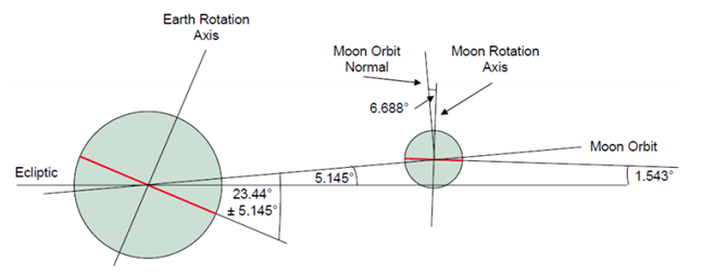 It is widely accepted that the Moon was created by a collision of a Mars size object with the Earth a few billion (thousands of years) years ago. One open question about it was on the tilt of the Moon's orbits. This week's Nature issue might give an answer to it and seems to be related with gold fever. When the solar system was being formed, the Earth was just a very hot ball, and many bodies were flying through the solar system, one big object collided with the forming Earth and the debris of that collision ended orbiting the Earth at about just 20,000 miles from it. Gravitational pull of the Sun, the Moon-Earth system and other objects made both objects draw away slowly to its current 200,000 miles (and still drawing away). The gravitational dance of the Earth and the Moon should have made the Moon to move in the same plane as the Earth is doing. But it happens that the orbit of the Moon is tilted about 5 degrees from the orbit of the Earth. This has been an open question until Kaleh Pahlevan and Alessandro Morbidelli from CNRS, Nice, France, published this week on Nature their research (Collissionless encounters and the origin of the lunar inclination). The solar system is not empty at all. There are lots of small objects moving through it, some of which impact into planets or satellites (Schoemaker-Levy), some of them are ejected from the solar system due to gravitational effects, some of them are swallowed by the Sun or might fall into a periodic stable orbit (Halley). The letter just published claims that collisionless impacts have been affecting Moons orbit to be those 5 degrees apart from Earth's orbit. Their simulations point in this direction and seem to be robust enough to a wide range of parameters. But the research also points to the fact that most of the impacts of objects have been on Earth and not on the Moon. The fact that the Moon is filled out of craters and not the Earth is due to the fact Earth has atmosphere, life on its surface and tectonics dynamics, which clear off any footprint of an impact, while the Moon hasn't. Between 9% and 25% of the objects that impact on the Earth-Moon system will do it on the Moon, while the rest on the Earth. This higher number of impacts could be the reason that the Earth has heavy metals on its surface, while the Moon hasn't. When the Earth was being formed, heavy, more dense metals should have gone deeper into the interior of the planet. Metals such as gold or platinum should not be found on its crust. The ones we find could provide from these impacts. Maybe yes, the gold fever was a lunatics matter.
0 Comments
Leave a Reply. |
Andrés AragonesesPhysicist, working in quantum optics and nonlinear dynamics in optical systems. Loves to communicate science. Archives
January 2018
Categories |
 RSS Feed
RSS Feed
